ISSN ONLINE(2319-8753)PRINT(2347-6710)
ISSN ONLINE(2319-8753)PRINT(2347-6710)
Swarna Surya Teja1, Paleru Siddhartha2
|
| Related article at Pubmed, Scholar Google |
Visit for more related articles at International Journal of Innovative Research in Science, Engineering and Technology
The uses of automobiles are increasing day by day because of that the waste of tyres increases. In India, the waste tyres are classified as solid waste. Due to manufacturing of tyres with synthetic rubber, proper disposal of these waste tyres has become difficult. It is approximately estimated as 60 to 70% of waste tyres are disposed in improper way in various areas. As a result of this, there is a great damage to eco-system like air pollution and aesthetic pollution. To avoid this damage we can utilize these tyre wastes with technical development in different fields like using tyre wastes in construction of flexible pavements. It is not only to decrease the pollution but also to decrease the use of aggregates which are in low quantity. In this investigation, we put our effort to make an effective use of waste tyres to stabilize the subgrade of highway pavement.
Keywords |
| Stabilization of Soil, CBR Test, Los Angeles Abrasion test, Crushing Value test, Impact Value test, Waste tyres Pieces. |
INTRODUCTION |
| In these days disposal of various wastages from various industries is a major problem. Many of them are nonbiodegradable so they expose environmental pollution in the surroundings. By using these wastes in place of conventional materials can reduce the cost of construction and to the safe disposal of waste. Generally Coarse aggregate, fine aggregate, bitumen, etc., are used in construction of roads. As usage of materials increasing day by day there is a decrease in quantity as a result, there is increase in cost. Taking this into consideration, the scientists are looking forward for alternatives in construction of highways by which we can reduce the pollution and disposal problems. Some of alternatives have found like fly ash, Zinc, slag, copper slag, etc., in construction of pavement. Due to the bulk use of solid waste in India, there was an experimental info to test and to develop these materials in a specified manner to enhance the use of waste tyres in laying roads which gives the possible high economic returns. In this way we can construct low volume roads. |
| The two main advantages determined from the pavement studies for the construction of low volume roads are: (i) It will help to protect the environment by preserving the natural resources (ii) It will also help to avoid from waste dumps. |
| Rubber tyres are user friendly but not eco-friendly as they are non-biodegradable generally. The practice of disposing waste tyres in landfills and open burning is becoming unacceptable because of rapid depletion of available landfill sites and clear environment respectively. Increase in transportation refers to increase in economic, industrial, social and cultural development of country. In India, there are around 5 lakh of villages are to be connected with road system. Though we made a forward planning majority of rural people in India doesn’t enjoy the accessibility of road system. To tackle the problem, preventive steps have to be taken compared to other alternatives like Recycled Bag Filter Dust, Crushing dust, etc., the tyre chips have drawn more importance in highway engineers due to their unique properties like light weight, reduce in thermal cracking, high resilience & great shock absorbance. The common cost of tyre chips is about Rs 800/- to Rs2400/- per cubic meter based on the quality and size. Usually In civil engineering applications, shredded tyres are known as “tyre chips”. The diameter of these tyre chips are between 15mm to 20 mm and length is between 20mm to 25mm of cylindrical shape. Approximately 20 million scrap tyres in 2000 and 25 million in 2002 have been used for civil engineering applications like clean fill for road embankment, leachate collection systems, landfill cover, artificial reefs, road bed support and similar projects. There are various advantages by using tyre chips in applications of Civil Engineering due to their unique characteristics compared to other light fill materials. These are in-expansive in nature. These tyre shreds possess high shear strength and low horizontal stresses since they are lightweight. However tyre shreds have not been tried extensively for using it in different layers of the pavement. In this investigation we made an attempt to find its possible uses in different layers of highway pavement. |
LITERATURE REVIEW |
| 1. Tatlisoz, Benson, Edil, (1997) decrypted soil-tyre chip mixtures are unique fill materials with high compressibility and ductility. Soil-tyre chip mixtures also have unique mechanical properties that are primarily governed by the tyre chip content, not by soil type. 2. Zornberg, Costa, Vollenweider, (2000) conducted a field investigation to assess the mechanical behaviour of an experimental embankment fill built with tyre shreds and cohesive soil. Immediately after construction, the embankment was submitted to heavy truck traffic and settlements were monitored for over two years. The results indicate that the embankment sections built with tyre shreds and cohesive soil showed satisfactory long term performances during traffic exposure. 3. Tatlisoz, Edil,Benson, (2001) assessed the shear strength and geosynthetic interaction of tyre chip and soiltyre chip backfills that may be used for geosynthetic reinforced walls and embankments and concluded that Soil-tyre chip mixtures have significantly higher shear strength than the soil used in the mixture. 4. Hassana, Hassan,Marei, Hashem, (2005) based on their tests involving triaxial test and CBR test on shred tyre reinforced soil, concluded that the presence of shredded waste tyres in sand improves the stress-strain properties for all different sizes and contents of shreds waste tyre over that pure sand. The maximum deviator stress of randomly reinforced sand occurs at a higher axial strain compared to sand alone. CBR values increases with the increase of shreds tyre content up to 3 % content. After this content the increasing of CBR value decreases with the increase of shreds tyre content in both soaked and unsoaked specimens. 5. Prasad, Prasad Raju, Ramana Murthy,(2008) carried out CBR and direct shear tests for finding the optimum percentages of waste plastics and waste tyre rubber in gravel subbase material. Based on these results, laboratory model pavement studies were conducted with optimum percentage of waste plastics and waste tyre rubber in gravel subbase, laid on expansive soil subgrade in the flexible pavement system. The load carrying capacity of the model flexible pavement system significantly increased when the gravel subbase was reinforced with waste plastics as well as waste tyre rubber when compared to unreinforced subbase. 6. Bosscher and Edil (1992, 1994) studied on soil-tyre chip mixtures and indicated improved frictional characteristics, increased resistance to dynamic loading and improved drainage characteristics of the soil. The tyre chips having size less than 20 mm have been used. 7. Mc. Donald (1996) developed rubber-bitumen compositions containing up to 25% cryogenically recovered rubber tyre. It has been reported that at high temperatures, jelly like material with improved elastic properties is produced. The blends were recommended for prevention of reflection cracking in bituminous pavements. 8. Alocke and Gregg, Oliver, Jain and ShuklaNagarajan and Thirunavakkarasu, (1992) made attempts to investigate the effect of Rubber Additive in Bituminous Paving Mixture and it is reported that partial replacement of rubber can be made in bitumen without much affecting the properties of bitumen. The rubber from discarded tyres received greater attention due to comparative cost and prevention of air pollution from environmental point of view. 9. S.Yoon et al. (2006) reported the performance of a test embankment constructed of Sand-Tyre shred mixture as fill material. The embankment was observed to perform satisfactorily exhibiting a maximum settlement of 12 mm. |
EXPERIMENTAL INVESTIGATIONS |
| MATERIALS USED: |
| 1) SOIL: |
| ThesoilusedforthisinvestigationisobtainedfromNH5nearTangutur,Ongole, Prakasam Dt.Thedriedandpulverizedmaterialpassingthrough I.S.4.75 mm sieve is taken for the study. The properties of the soil are given in Table.1. The soil is classified as “SC”asperI.S.Classification(IS1498:1970)indicatingthatitisclayeysand. |
| TABLE:1 PROPERTIES OF UNTREATEDSOIL |
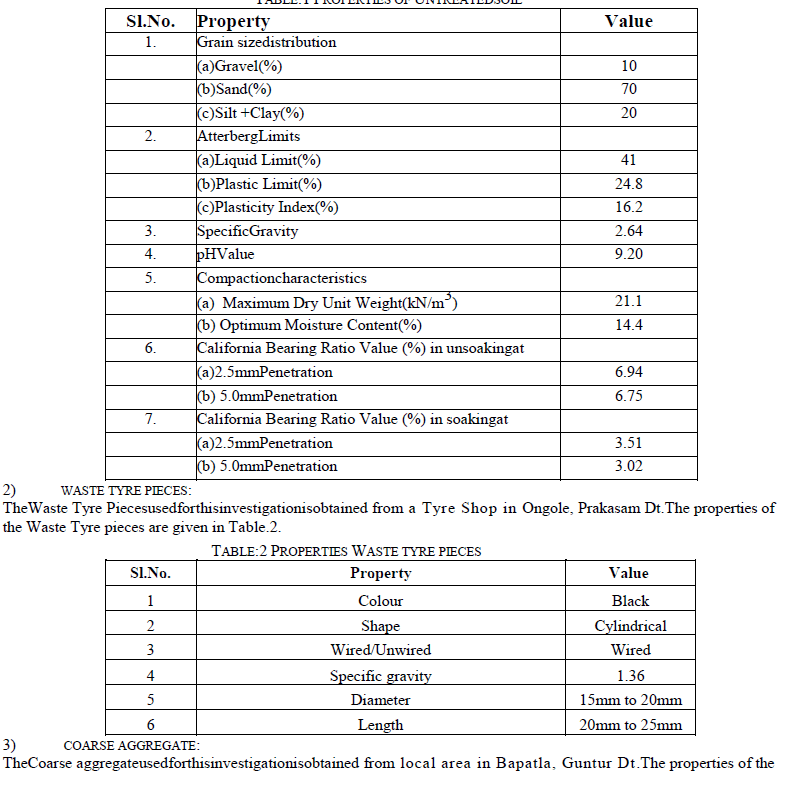 |
 |
PROCEDURE OF MIXING |
| Thesoilfromthesiteisdriedandhandsortedtoremovethepebblesandvegetativematterifany.Itisfurtherdriedandpulverized andsievedthroughasieveof4.75mmtoeliminategravelfractionifany. The Soil is sun dried for 24 hours and again oven dried for 24 hours to remove moisture content present in it.The dried andsieved soilis stored in air tight containers and ready to use for mixing with Waste tyre pieces. The soil mixed with water of chosen moisture content and storedof a day for uniform distribution of water in different containers. Thes oil sample so prepared is mixed with waste tyre pieces in different proportions. The percentage varied as 0%, 2.5%, 5%, 7.5%, 10%.Thesoil–waste tyre pieces are mixed thoroughly before testing. |
TESTS CONDUCTED |
| TEST CLAUSES: |
| Tests are divided into 3 Clauses |
| 1. FIRST CLAUSE |
| In the first clause of the test on soil, waste tyre pieces were considered as an additive material that can be added to the soil like lime and fly ash. The composite material can be called as waste tyre replaced soil or soil-waste tyre mix. Waste tyre was added to the soil in proportions of 2.5, 5, 7.5 and 10 in terms of percentage by weight of the soil and compaction tests were carried out to determine their optimum moisture contents at the respective tyre contents. CBR tests were also performed on soil-waste tyre mix with given percentages of waste tyre pieces in unsoaked condition. Standard proctor compaction was adopted in the preparation of specimens for CBR tests |
| 2. SECOND CLAUSE |
| In the second clause of the test on soil, waste tyre pieces were considered as a reinforcing material like geosynthetics. CBR tests were performed on the sample which contained partially replaced waste tyre pieces in proportions of 2.5, 5, 7.5, 10 and 12.5 by weight of the soil to determine the optimum waste tyre content in soaked condition. Since the tyre was considered as a reinforcing material, all the samples were compacted at optimum moisture content of the soil. Waste tyre pieces were randomly placed during compaction. Standard proctor compaction was adopted in the preparation of specimens for CBR tests. |
| 3. THIRD CLAUSE |
| In the third clause of the test on aggregates, CBR tests were performed on the sample which contained partially replaced waste tyre pieces in proportions of 2.5, 5, 7.5, 10 and 12.5 by weight of the aggregates to determine the optimum waste tyre content in unsoaked condition. Standard proctor compaction was adopted in the preparation of sample for CBR test. For the same percentages of waste tyre pieces, aggregate crushing value test, abrasion test and impact test were also performed. |
RESULTS AND DISCUSSION |
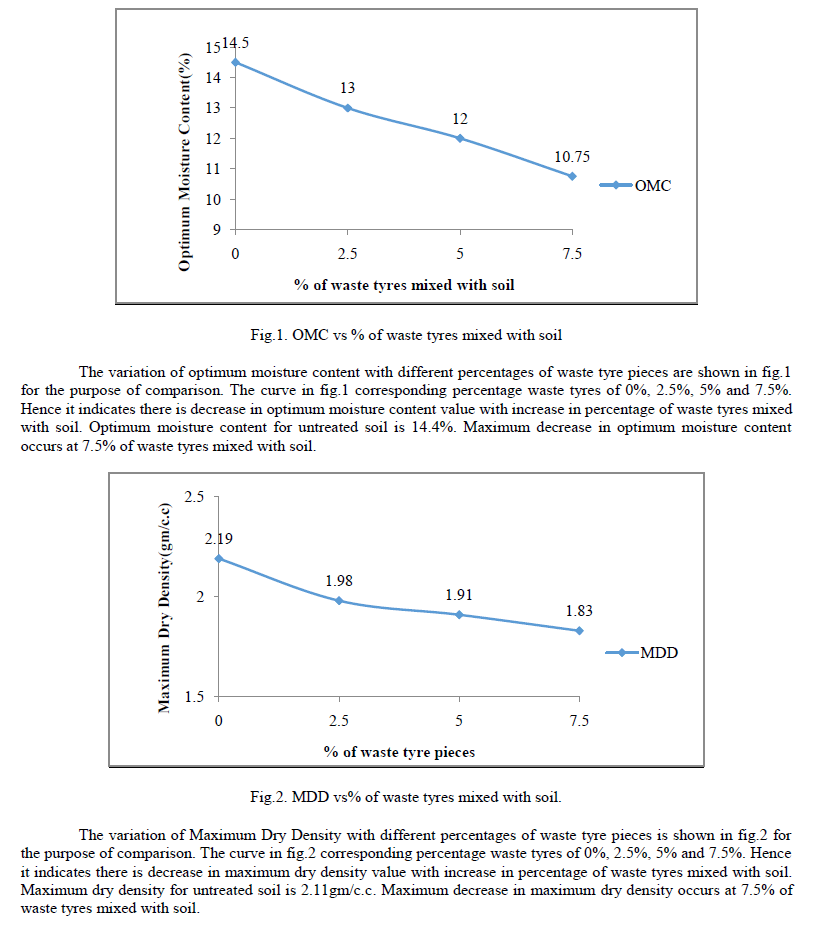 |
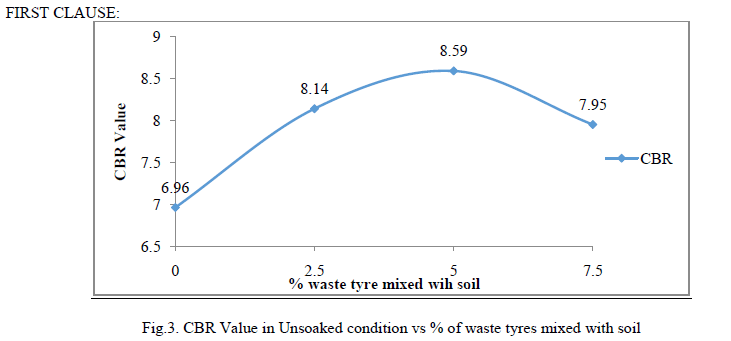 |
| The variation of CBR value with different percentages of waste tyre pieces is shown in fig.3 for the purpose of comparison. The curve in fig.3 corresponding percentage waste tyres of 0%, 2.5%, 5% and 7.5%. Hence it indicates there is increase in CBR value with increase in percentage of waste tyres mixed with soil upto 5% and then decreasing for 7.5%. CBR value for untreated soil in unsoaked condition is 6.96%. Soil reinforced withWaste tyre pieces showed improvement in CBR vaule with its addition upto 5% and there onwards decreased with further increase in waste tyre content in unsoaked conditions. These results are agreeing with that of R. M. Subramanian and S. P. Jeyapriya who studied the “Effect of Waste Tyres in Flexible Pavement System”. |
| SECOND CLAUSE |
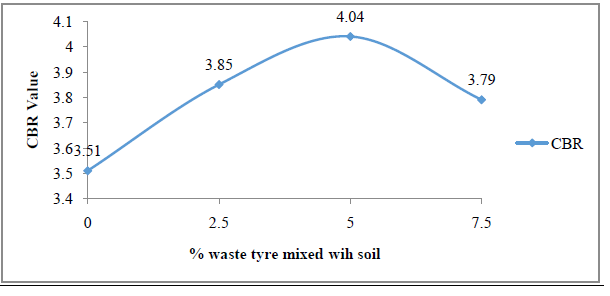 |
| Fig.4. CBR Value in Soaked condition vs % of waste tyres mixed with soil |
| The variation of CBR value with different percentages of waste tyre pieces is shown in fig.4 for the purpose of comparison. The curve in fig.4 corresponding percentage waste tyres of 0%, 2.5%, 5% and 7.5%. Hence it indicates there is increase in CBR value with increase in percentage of waste tyres mixed with soil upto 5% and then decreasing for 7.5%. CBR value for untreated soil in soaked condition is 3.51%. Soil reinforced withWaste tyre pieces showed improvement in CBR value with its addition upto 5% and there onwards decreased with further increase in waste tyre content in soaked conditions. |
| COMPARISION BETWEEN SOAKED AND UN SOAKED: |
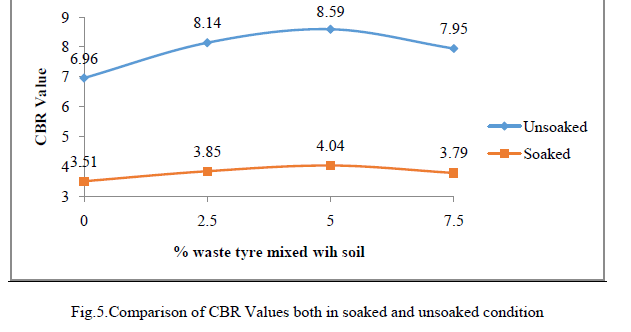 |
| The variation of CBR value with different percentages of waste tyre pieces is shown in fig.5 for the purpose of comparison between soaked and unsoaked condition. The curve in fig.5 corresponding percentage waste tyres of 0%, 2.5%, 5% and 7.5%. Hence it indicates there is increase in CBR value with increase in percentage of waste tyres mixed with soil upto 5% and then decreasing for 7.5% in the case of both soaked and unsoaked condition. CBR values for untreated soil in soaked and unsoaked condition are 6.96% and 3.51% respectively. Soil reinforced withwaste tyre pieces showed improvement in CBR value with its addition upto 5% and there onwards decreased with further increase in waste tyre content in both soaked and unsoaked conditions. |
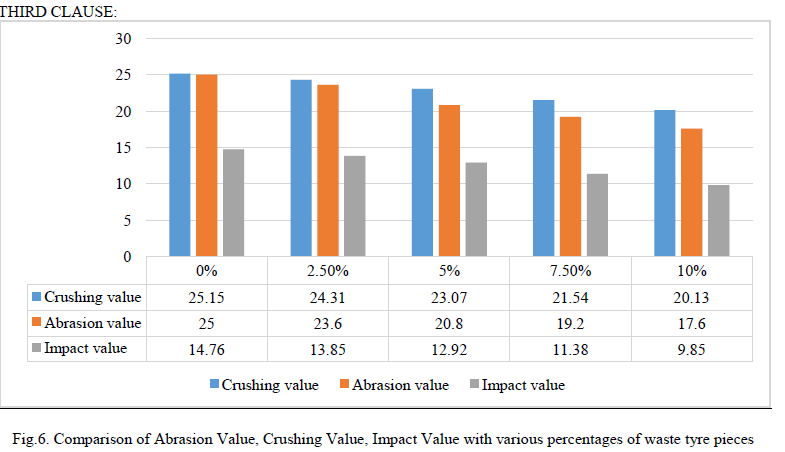 |
| The variation of Abrasion Value, Crushing Value, and Impact Value with different percentages of waste tyre pieces is shown in fig.6 for the purpose of comparison. The bar chart in fig.6 corresponding percentage waste tyres of 0%, 2.5%, 5% and 7.5%. Hence it indicates there is decrease in Abrasion value, Crushing Value & Impact Value withincrease in % of waste tyres mixed with soil. Abrasion Value, Crushing Value & Impact Value for untreated aggregate is 25%, 25.15% and 14.76% respectively. The Abrasion Value, Crushing Value, Impact Value decreases as the percentage of waste tyre pieces increases, because the waste tyre pieces possess high wear and tear, strength, toughness. At optimum waste tyre content there is a considerable decrease in abrasion value, crushing value, impact value which proves them to be a better composite material to be used in subbase layer than aggregate alone. |
SUMMARY &CONCLUSION |
| The rapid growth in automobiles causes generation of large quantities of waste tyres. Use of waste tyres in subgrade stabilization is one of the methods of safe disposal.With all these, it is a good saving too. No toxic gas is produced. Disposal of waste tyres will no longer be a problem. The use of waste tyres on the road has helps to provide better place for buying the used tyres waste without causing disposal problem. At the same time, a better road is also constructed. It also helps to avoid the general disposal technique of waste tyres namely land-filling and open burning, which have certain burden on ecology. |
| Soil reinforced with Waste tyre pieces showing improvement in CBR value with its addition upto 5% and there onwards decreased with further increase in tyre content in both soaked and unsoaked conditions An increase in CBR value of 1.63% can significantly reduce the total thickness of the pavement and hence the total cost involved in the project. Aggregates in subbase layer when partially replaced by waste tyre pieces showed considerable increase in CBR value with increase in tyre content upto 5% and there onwards decreased with further increase in tyre content. Aggregates when partially replaced by waste tyre pieces showed considerable decrease in abrasion value, crushing value and impact value which proves them to be better composite material in the subbase layer of the pavement system. |
References |
|